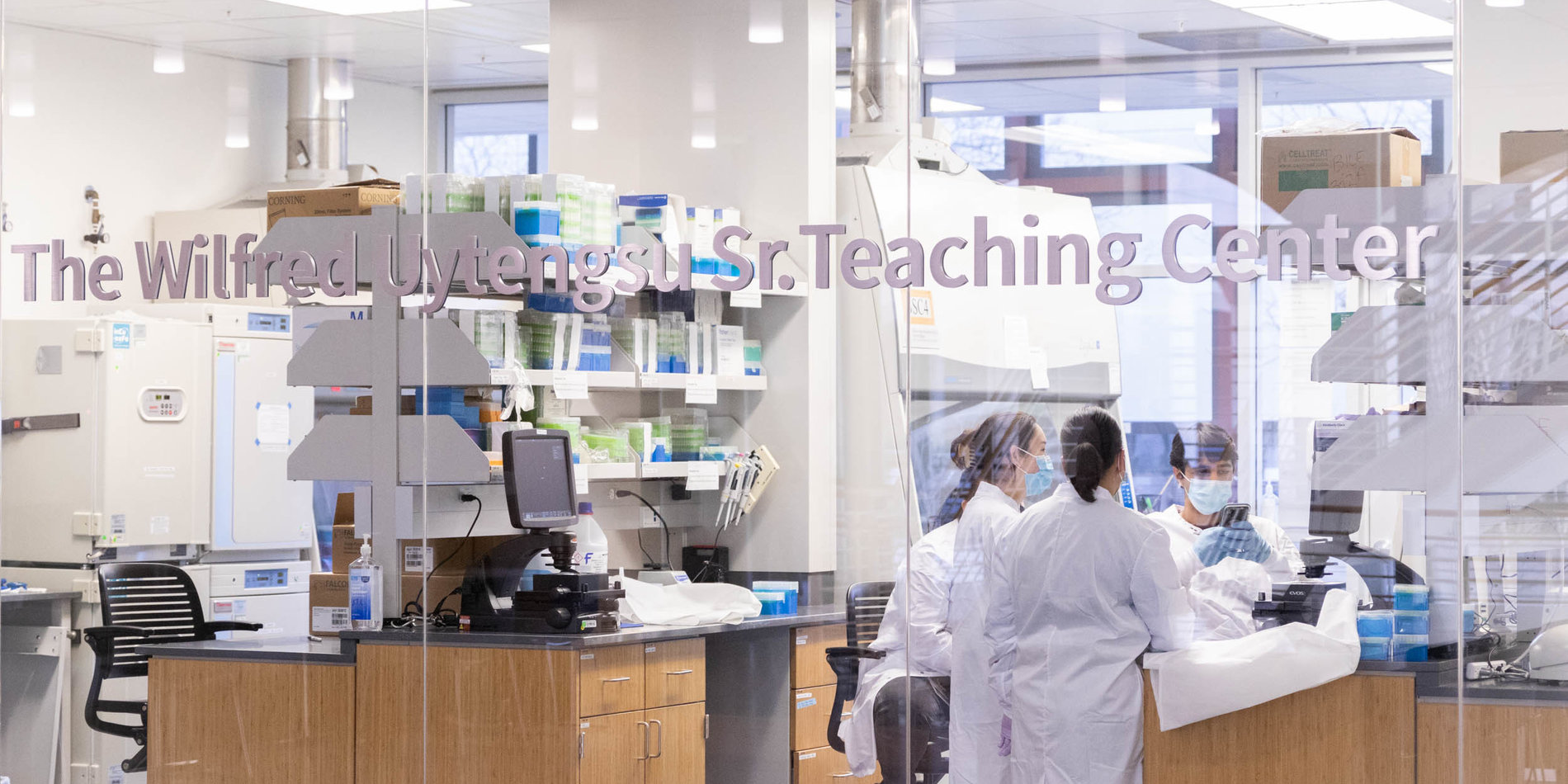A shared space for science
Walk into the Uytengsu Teaching Laboratory at Stanford’s Shriram Center and you enter a world of possibilities.
Amid its 10,000 square feet of state-of-the-art laboratories and instruments, the facility, also known as the Uytengsu Teaching Center, offers something else: a rare chance for students – mostly undergraduates – to experience the thrill of pursuing original ideas in a quest for new discoveries, says Ross Venook, a senior lecturer in bioengineering.
“One of the powers of this lab is that it’s been designed to enable open-ended, student-driven projects,” says Venook. “In order to support that, you need a space that has the flexibility to go in any direction. Here, the sky’s the limit.”
Free-direction research
Embedded on the first floor of Stanford’s Shriram Center, home to the departments of Bioengineering and of Chemical Engineering, the Uytengsu Teaching Lab (UTL) was made possible by a gift from Bonnie Uytengsu in memory of her late husband, Wilfred Uytengsu Sr., a 1950 Stanford graduate, engineer, and entrepreneur. Opened in fall of 2014, its specialized equipment and lab spaces are designed to serve as a center for undergraduate teaching, says UTL director Jeffrey Tok, who oversees the facility with lab manager Mong Saetern.
“At the time it was built, this was the first shared teaching lab space on campus,” Tok says. “The concept was to better serve our bio- and chem-related courses and activities in an efficient and safe space, and to give students easy access to a myriad of teaching instruments and facilities housed in a consolidated way. I believe this teaching space to be one of the best in the country, if not the world.”
The extensive facilities include labs for wet and dry research, tissue culture, design, electronics, and machining.
“This space doesn’t cater to any particular department,” Tok says. “Our labs have been used by students from the schools of Engineering, Medicine, Humanities and Sciences, and the Doerr School of Sustainability. In addition, more than 40 percent of the work here is done by members of undergraduate research clubs who need to carry out experiments. This is free-direction type of research, and involves students from bioengineering, chemical engineering, chemistry, and materials science working together.”
Resources for creativity
Every aspect of the Uytengsu Lab, from its modular design, moveable tables, and small meeting rooms to its collection of high-tech instruments (think 3D bioprinter, DNA printer, biosafety level-2 tissue culture lab, walk-in cold room) is designed to promote flexibility and creativity, says Venook, who leads a two-quarter capstone course and other hands-on courses and workshops based at the lab.
“Students might be working to create an app, a biopharmaceutical, a diagnostic test, or a gene therapy using CRISPR,” he says. “Rather than having them use identical sets of the same equipment to replicate projects that a thousand people have done before them, we’re able to give them a project experience that includes unmet challenges – because we have a little bit of everything here. They’re not limited by their equipment, and that creates a sense that it doesn’t matter what project they dream up; we’ll find a way to support it.”
Projects undertaken at the UTL have included the development of low-cost saliva tests for detecting COVID-19; easy-to-manufacture ventilators that could be produced globally; the study of DNA synthesis in space; and a device that safely secures umbilical catheters in newborns to prevent common bloodstream infections.
Stanford engineering student Thomas Colburn has participated in several projects at the UTL, including one as an undergraduate for his research capstone course in chemical engineering. Tasked with exploring an aspect of energy that would add a new contribution to the field, and mentored by graduate student Chris Cooper, Colburn and three other undergraduate team members worked on developing a flexible material using molecules capable of absorbing solar energy and later releasing heat. The group’s work was published in the peer-reviewed Journal of Physical Chemistry C, a rare accomplishment for an undergraduate team.
“That result is a testament to the resources we had at the Uytengsu Center, which allowed us to dive into this topic and contribute enough that a journal saw the work as relevant for their publication,” says Colburn, now a third-year PhD student in materials science. “The UTL gave us a sandbox, with the space to be creative and really delve into a unique aspect of science that we were interested in and excited about.”
A makerspace feel
The Uytengsu Lab also hosts special events and serves as a laboratory space for a range of student organizations including the Stanford Student Space Initiative, the Stanford Solar Car Team, and Biological Interdisciplinary Open Maker Environment (BIOME). Alan Tong, a senior majoring in biology and chemistry, has worked on projects at the UTL since he was a first-year member of BIOME.
“We’re explorers,” says Tong, who also works as a safety officer at the UTL. “BIOME’s goal is to give undergrads the resources, lab space, and funding to do their own projects. The Uytengsu Lab is amazing; it’s very collaborative, and part of the experience there is learning about what others are doing. Recently I saw someone there running an experiment to analyze a lipase, while others were trying to label a protein using a fluorescent protein probe.”
That collaborative atmosphere, combined with its resources and a dedicated staff, make the Uytengsu Lab an integral part of the Stanford Engineering experience, says Colburn.
“Its makerspace feel and the technological precision accessible in the UTL opens the door to helping us believe in ourselves,” he says. “This space is a student research accelerator that pushes you forward and helps you believe you can put forward meaningful advances. I felt like it was a place where I could let my mind go free, and where I had the tools and support to make my ideas a reality.”



